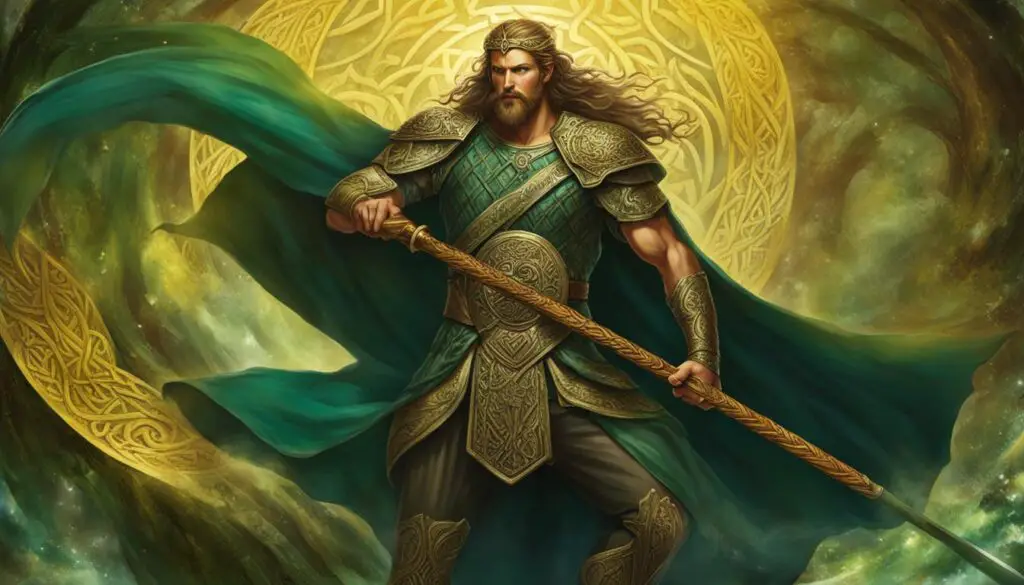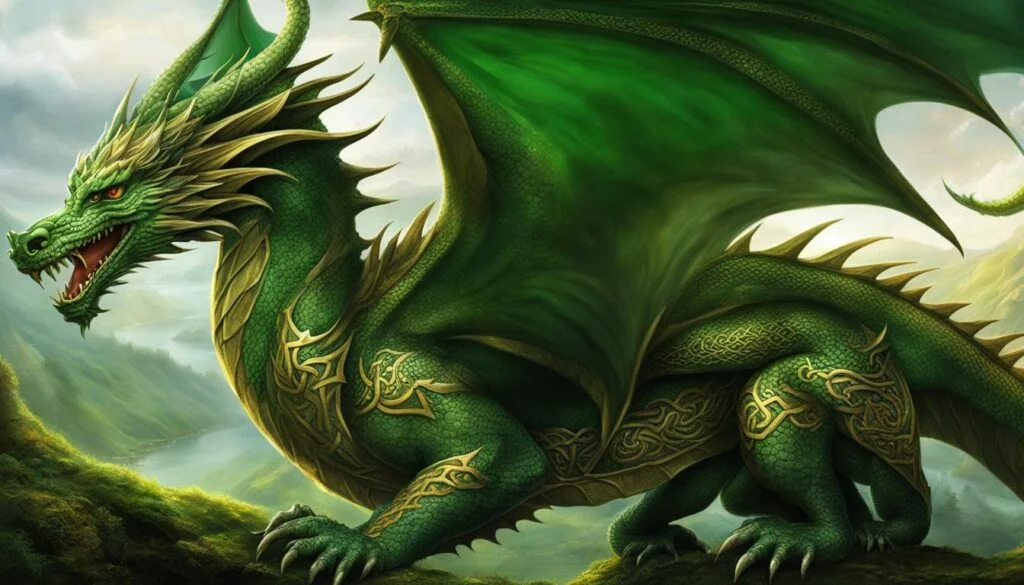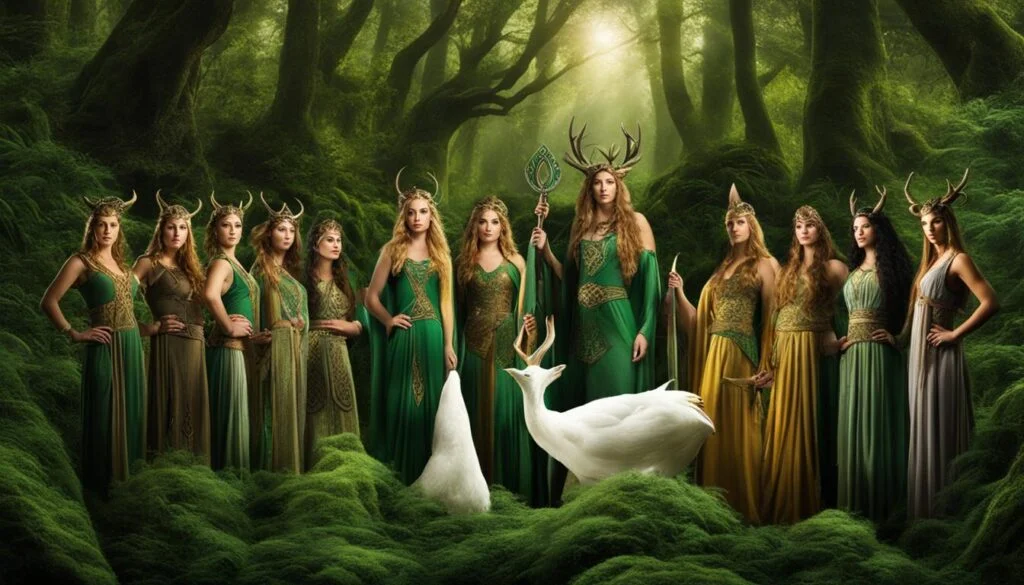Welcome to our exploration of Celtic mythology, where we delve into the fascinating world of Lugh, the Celtic god celebrated for his mastery of skills. Lugh, also known as Lugh of the Tuatha Dé Danann, holds a significant role in Celtic folklore and ancient mythology. Let’s uncover the captivating stories, attributes, and cultural significance surrounding Lugh and his divine powers.
Key Takeaways:
- Lugh, a central figure in Celtic mythology, is revered for his skills and expertise in various domains.
- He is a member of the legendary Tuatha Dé Danann, powerful supernatural beings integral to Irish folklore.
- Lugh’s attributes include craftsmanship, warrior skills, wisdom, and a trickster nature.
- His mythology is filled with epic tales, such as his roles in the Battle of Mag Tuired and the defeat of the Fomorian king Balor.
- Lugh’s cultural importance is seen in festivals like Lughnasa and his continued influence in contemporary neo-paganism.
Lugh’s Family and Lineage in Celtic Mythology
Lugh’s family and lineage in Celtic mythology are intricate and fascinating, reflecting the complex nature of his origins. Born from the union of Cian, a member of the Tuatha Dé Danann, and Ethniu, the daughter of the formidable Fomorian ruler Balor, Lugh possessed a unique heritage that bridged the divide between these powerful mythological factions.
With his mixed parentage, Lugh’s ancestry symbolized the intertwining of the Tuatha Dé Danann and the Fomorians, two influential forces in Celtic mythology. This lineage bestowed upon him exceptional abilities and a divine destiny.
Lugh’s romantic relationships played a significant role in his mythology and had notable effects on his lineage. His consorts included Buí, Nás, and Deichtine of Ulster, with whom he fathered children who would go on to become legendary figures in their own right.
One of Lugh’s most renowned children was Cu Chulainn, a valiant hero who played a pivotal role in the Ulster Cycle of Irish mythology. Cu Chulainn’s lineage traced back to Lugh, emphasizing the importance of Lugh’s family in the narrative of Celtic mythology.
The intricacies of Lugh’s family and lineage add depth to his character, as well as provide a context for his role as a savior and hero in Celtic mythology. These connections highlight the rich tapestry of ancient Celtic tales and the lasting impact of Lugh’s lineage on the mythological landscape.
Lugh’s Skills, Attributes, and Domains
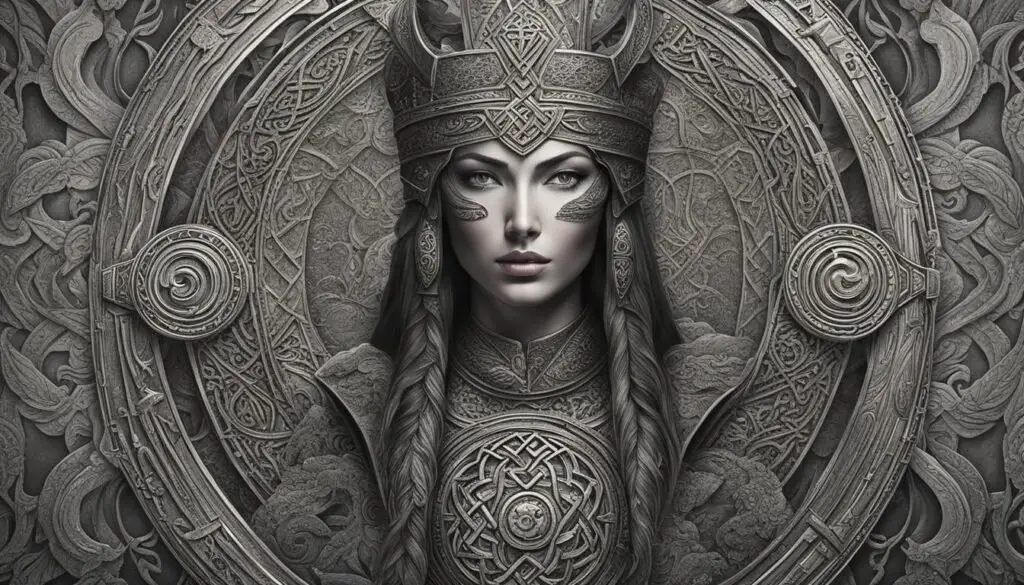
Lugh, the revered deity in Celtic mythology, possessed a wide range of impressive skills and attributes. Known for his mastery in various domains, he was highly regarded as both a skilled artisan and a formidable warrior.
Lugh’s craftsmanship was renowned throughout the Celtic lands. An expert in the arts, he showcased his artistry and inventiveness through his intricate creations. Whether it was exquisite jewelry, finely crafted weapons, or intricate sculptures, Lugh’s craftsmanship was unparalleled.
But Lugh’s skills were not limited to the realm of craftsmanship alone. He was a fearsome warrior, equipped with powerful weapons and unmatched prowess. The Spear of Assal, the Fragarach sword, and a slingshot were among his formidable armaments.
However, Lugh’s mastery extended beyond physical skills. He excelled in various forms of artistic expression, including poetry and music. As a patron of the arts, Lugh not only created masterpieces but also inspired others to explore their own creative potential.
Alongside his skills and mastery, Lugh was known for his trickster nature. He was cunning and willing to use deception to outsmart his adversaries. This aspect of his persona added a layer of complexity to his mythology and made him a multifaceted character.
In addition to his creative and warrior skills, Lugh was associated with justice and law. He was known for his swift and ruthless judgments, ensuring that justice prevailed and truth was upheld.
Overall, Lugh’s diverse skills, attributes, and domains contributed to his revered status in Celtic mythology. His craftsmanship, warrior skills, creativity, trickster nature, and commitment to justice all combined to make him a truly extraordinary and multifaceted deity.
Lugh’s Mythology and Legends
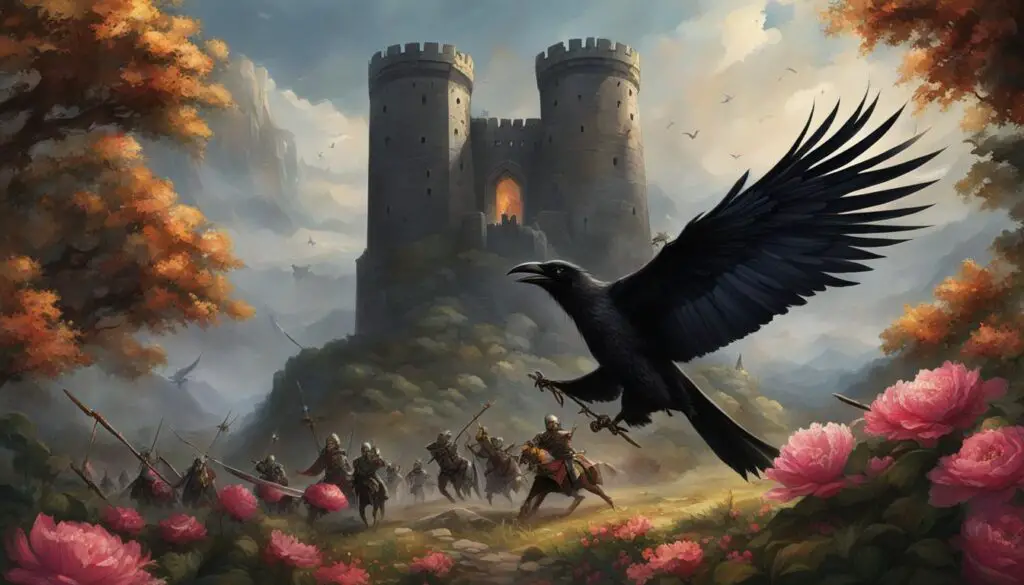
Lugh’s mythology is filled with epic tales and legends that have captivated generations. These stories transport us to a realm of gods, heroes, and battles that shaped the ancient Celtic world.
One of the most significant moments in Lugh’s mythology is his role in the Battle of Mag Tuired, a legendary conflict between the Tuatha Dé Danann and the Fomorians. Lugh’s birth is often intertwined with this battle, with various accounts highlighting his divine parentage and the circumstances surrounding his arrival.
In the battle, Lugh proved to be an instrumental figure, wielding his formidable skills and wisdom to lead the Tuatha Dé Danann to victory. Lugh’s defeat of the fearsome Balor, the Fomorian king, is a legendary feat, as he used a stone from his slingshot to deliver a fatal blow.
Not only did Lugh triumph over Balor, but he also played a crucial role in the defeat of Bres, another Fomorian king. Lugh’s tactical brilliance and unmatched abilities contributed to the ultimate victory of the Tuatha Dé Danann over their enemies.
Tragically, Lugh’s victory came at a cost. After the Battle of Mag Tuired, Lugh’s reign marked the beginning of the decline of the Tuatha Dé Danann. His eventual death had a profound impact on Celtic mythology and Irish folklore, leaving behind a lasting legacy.
Today, Lugh’s mythology and legends continue to inspire awe and fascination. His stories serve as a reminder of the power and resilience of the Celtic gods and the timeless allure of ancient mythology.
Lugh’s Symbolism and Significance in Celtic Culture
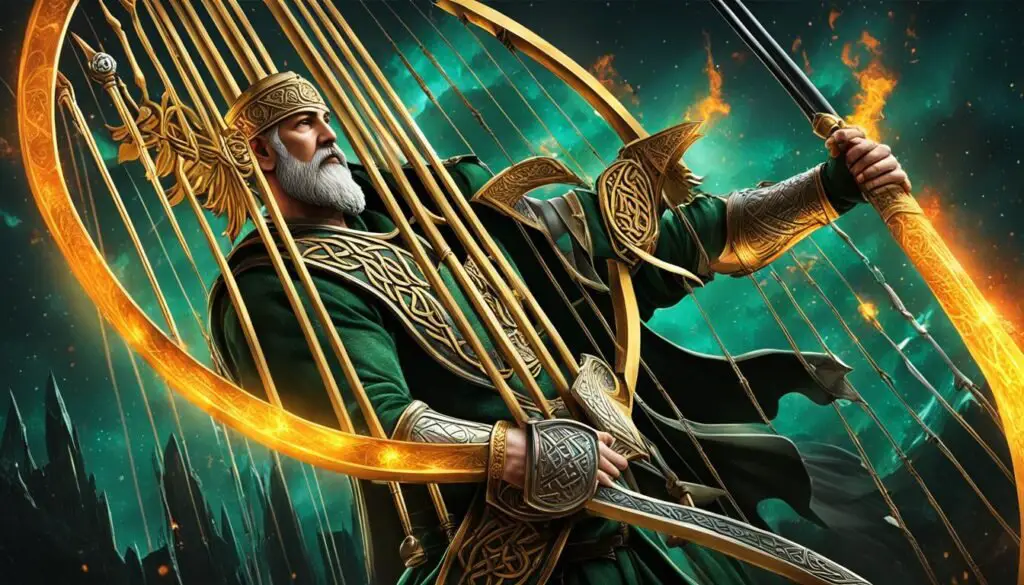
Lugh, the Celtic deity, holds profound symbolism and significance in Celtic culture. His portrayal embodies the ideals of skill, craftsmanship, and wisdom. As a revered figure, Lugh is closely associated with various significant festivals, with the most prominent being Lughnasa, a harvest festival celebrated on August 1st. This festival serves as a tribute to Lugh’s victory over the spirits of Tír na nÓg and symbolizes the abundance of the harvest season.
In Celtic art and iconography, Lugh is often depicted as a youthful and handsome warrior, representing bravery and prowess. His name carries widespread recognition among modern-day Celtic communities, highlighting his enduring cultural importance. Lugh’s presence is still prevalent in folklore and festivals, where his legend and attributes are remembered and celebrated.
Lugh’s symbolism resonates with the core values of Celtic culture and continues to inspire individuals seeking connection to their ancestral traditions. The ideals of skill, craftsmanship, and wisdom embodied by Lugh serve as a source of inspiration and guidance for those striving to develop their talents and pursue excellence in various domains.
Lugh’s Festivals and Representations
- Lughnasa: The annual festival of Lughnasa, held on August 1st, marks Lugh’s victory and celebrates the bountiful harvest season.
- Representations: Lugh is often portrayed in art and iconography as a youthful and handsome warrior wielding prominent symbols of his abilities, such as weapons or crafting tools.
Through his festivals and representations, Lugh’s cultural significance remains ever-present, ensuring his legacy as a revered figure in Celtic mythology and an embodiment of the Celtic spirit.
Lugh’s Influence and Legacy in Modern Times
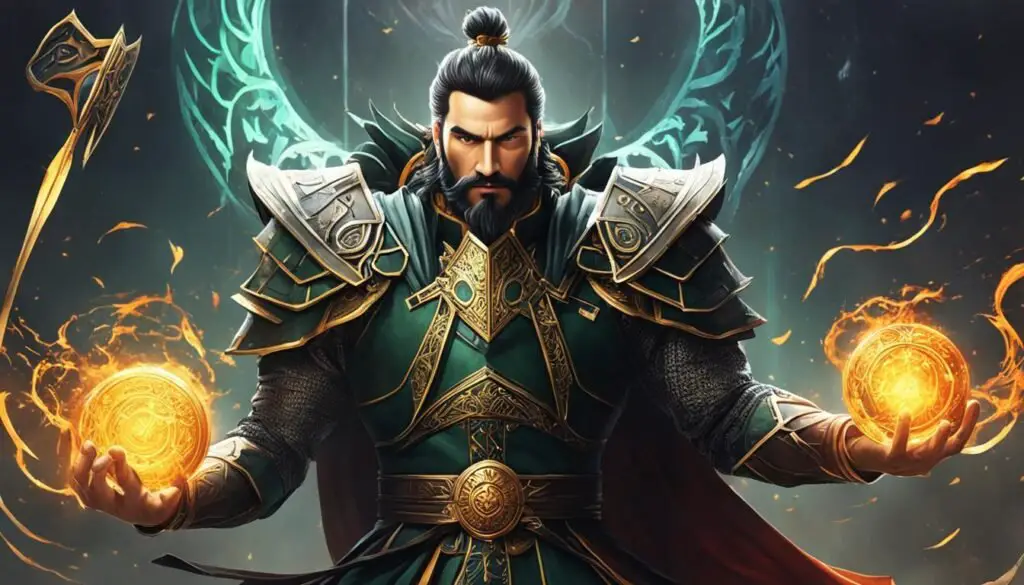
Although Celtic mythology is ancient, Lugh’s influence and legacy continue to be felt in modern times. He remains a prominent figure in neo-paganism and other spiritual practices that draw inspiration from Celtic traditions. The stories and symbolism associated with Lugh resonate with individuals seeking a connection to their Celtic heritage and a deeper understanding of ancient wisdom.
Lugh’s cultural impact can be seen in the continued celebration of festivals like Lughnasa, which honor his role as a symbol of exceptional skill and mastery. These festivals bring communities together to celebrate the harvest season and recognize the importance of craftsmanship and artistry.
In addition to his continued presence in mythology and folklore, Lugh’s influence extends to contemporary cultural expressions. His stories and attributes inspire creativity and serve as a reminder of the power of the human spirit. Lugh’s legacy lives on in the arts, literature, music, and other forms of artistic expression that pay homage to Celtic traditions.
In neo-pagan and spiritual circles, Lugh is revered as a divine figure who embodies the qualities of courage, wisdom, and mastery. Many individuals draw inspiration from Lugh’s tales to navigate life’s challenges and strive for personal growth and excellence.
Overall, Lugh’s influence and legacy transcend time, reminding us of the enduring power of myth and the cultural significance of ancient traditions. From celebrations to contemporary art, Lugh’s presence continues to enrich our lives and connect us to our Celtic roots.
Conclusion
Lugh, the Celtic deity renowned for his exceptional skills, versatility, and valor, holds immense significance in Celtic mythology and culture. As a master craftsman, formidable warrior, and wise ruler, Lugh’s character epitomizes depth and complexity. His enthralling mythology and legends portray him as a pivotal figure in battles, triumphing over formidable foes, and contributing to the victory of the Tuatha Dé Danann.
The cultural importance and symbolism surrounding Lugh continue to be cherished and celebrated in modern times, ensuring his legacy as a divine figure and cultural hero endures in the hearts and minds of those connected to Celtic traditions. Lugh’s profound influence extends beyond myth and legend, shaping contemporary cultural expressions and spiritual practices rooted in Celtic heritage.
From his role as the skilled god of craftsmanship to his associations with justice and law, Lugh’s multifaceted character embodies the ideals and wisdom cherished by Celtic communities. His representation as a youthful and brave warrior remains prominent in art and iconography, capturing the imagination of those drawn to his legends. Lugh’s cultural significance endures, making him an enduring symbol of skill, mastery, and ancestral wisdom.
FAQ
Who is Lugh?
Lugh, also known as Lugh of the Long Arm or Lug, is a prominent figure in Celtic mythology. He was a master of crafts, a skilled warrior, and a wise ruler. Lugh was a member of the Tuatha Dé Danann, a group of powerful supernatural beings in Irish folklore.
What is Lugh’s role in Celtic folklore?
Lugh is associated with a wide range of domains, including art, craftsmanship, weaponry, law, truth, and justice. His significance in Celtic mythology is reflected in his various titles and epithets, such as Lámfada (Of the Long Arm), Ildánach (the Skilled God), and Samildánach (equally skilled in all the arts).
What is Lugh’s lineage?
Lugh was the son of Cian, a member of the Tuatha Dé Danann, and Ethniu, the daughter of Balor, a powerful Fomorian tyrant. His mixed heritage from both the Tuatha Dé Danann and the Fomorians placed him in a unique position.
What are Lugh’s skills and attributes?
Lugh was a skilled craftsman, warrior, and ruler. His attributes included his trickster nature, as well as his association with justice and law. Lugh was known for his mastery in a wide range of skills, including craftsmanship, poetry, and music.
What are some of Lugh’s notable legends?
Lugh played a pivotal role in the Battle of Mag Tuired, where he defeated the formidable Balor by slaying him with a stone thrown from his slingshot. He also played a key role in the defeat of the Fomorian king Bres and the subsequent victory of the Tuatha Dé Danann.
What is Lugh’s significance in Celtic culture?
Lugh represents the ideals of skill, craftsmanship, and wisdom. He is associated with several significant festivals, such as Lughnasa, the harvest festival celebrated on August 1st. Lugh is also represented in various forms of art and iconography.
How does Lugh’s influence continue in modern times?
Lugh remains a prominent figure in neo-paganism and other spiritual practices that draw inspiration from Celtic traditions. His stories and symbolism resonate with those seeking a connection to their Celtic heritage and ancient wisdom. Lugh’s influence can be seen in contemporary cultural expressions.


